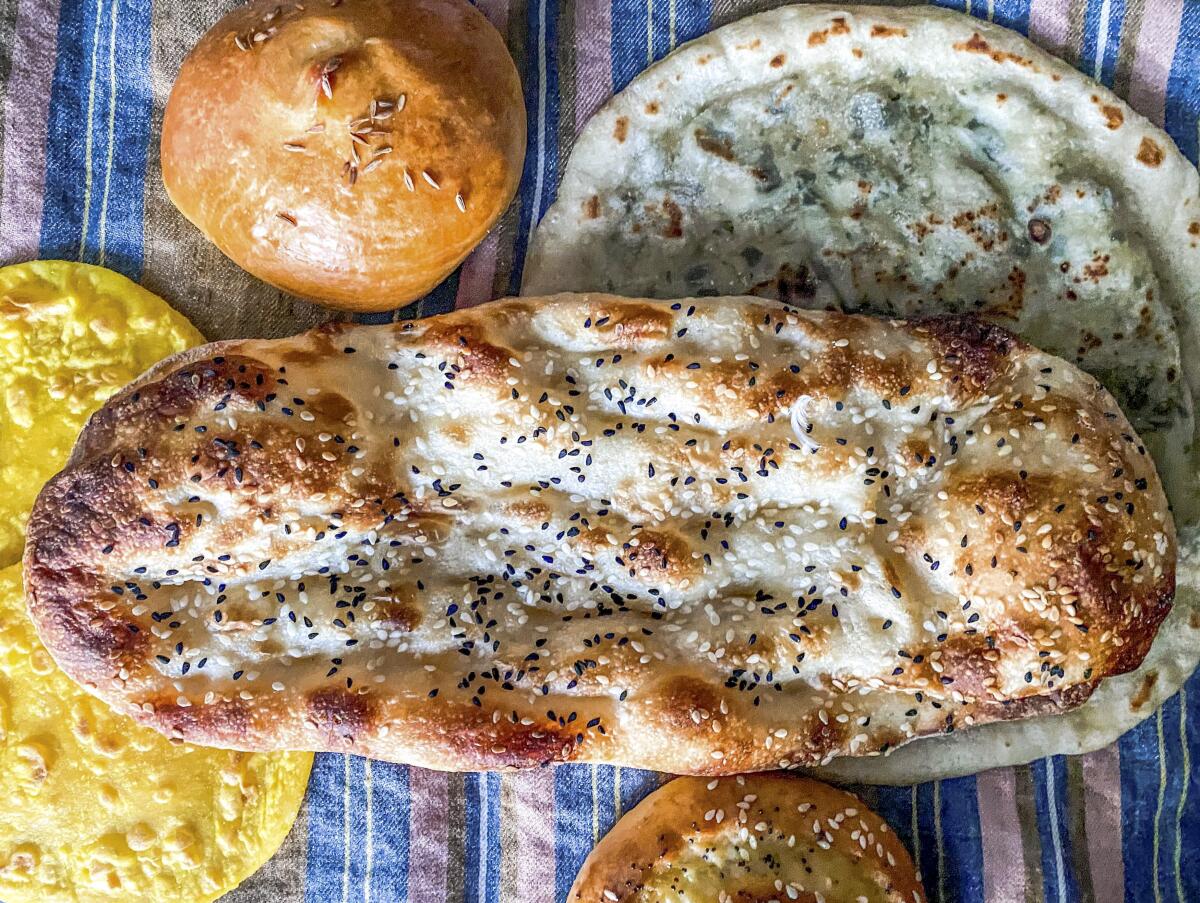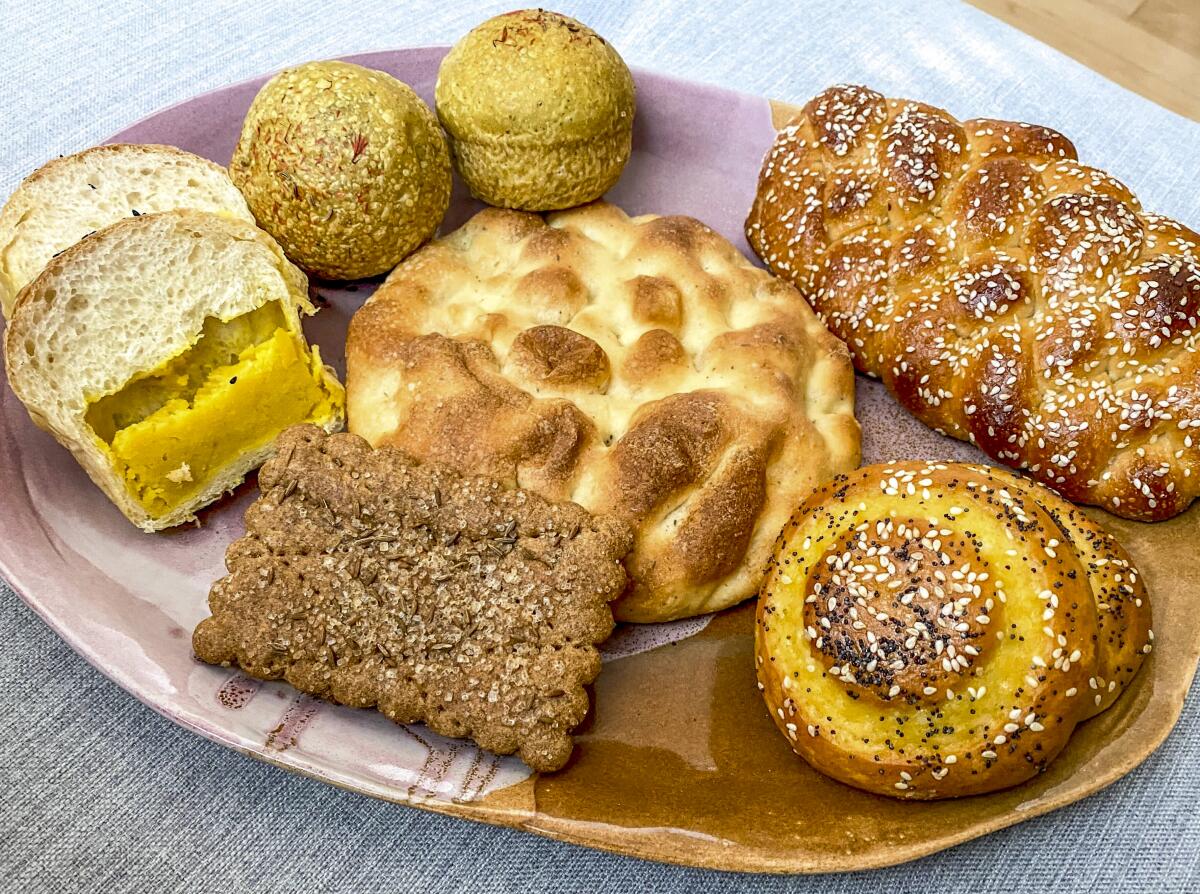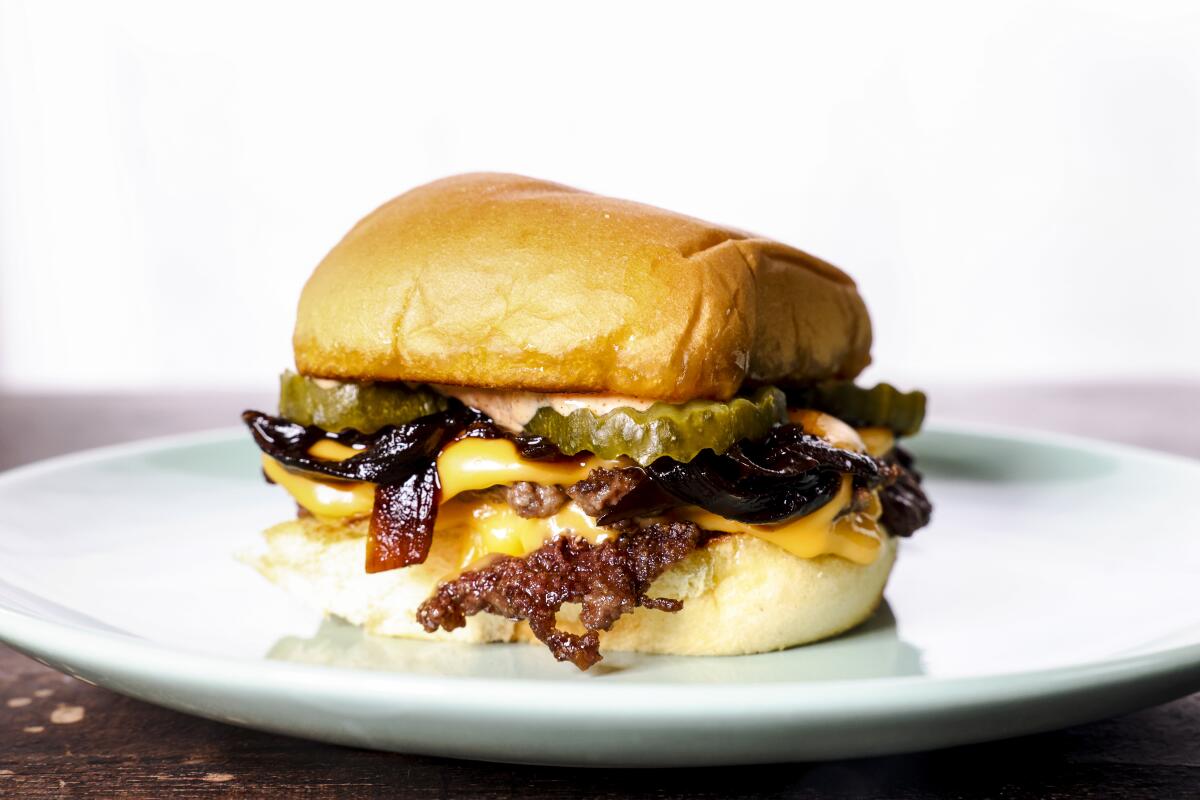Iranian flatbreads and spiced sweet rolls you have to try

- Share via
In 2018, pastry chef Sahar Shomali was between restaurant jobs — she’d concluded career-making stints at Spago and Lucques and would soon be making desserts at Hearth & Hound — when she was gripped by an idea for a side project. She began teaching herself to master barbari (sometimes called nan-e barbari or noon barbari), the oblong, chewy-crackery flatbread that is ever-present at Iranian meals.
Sure, she could find plenty of barbari around Los Angeles; Southern California is home to the largest population of Iranians outside of Iran. But she couldn’t put her hands on bread, baked using levain (or sourdough starter), that tasted like the classic version she grew up eating in Tehran.
Enjoying this newsletter? Consider subscribing to the Los Angeles Times
Your support helps us deliver the news that matters most. Become a subscriber.
“There are essentially two types of barbari,” Shomali said. “There’s the one that’s been made in Iran for centuries. That’s the one I wanted to re-create. Then there’s the modern version, made with commercial yeast and cooked in ovens designed for efficiency. That one is soft and fluffy and big and cheap to produce. In Farsi we call it the ‘machine-made barbari.’”
She tinkered with recipes and techniques until the results matched her memory — a medium-thick, modestly sized flatbread, covered in black and white sesame seeds, with low hills and valleys across its surface. It had a pronounced crispness and a direct but delicate tang to the flavor.
Shomali called her cottage bakery Kouzeh, a spare-time pursuit that specialized only in barbari.
When Hearth & Hound closed in 2019, though, Shomali began researching to expand her repertoire. She remembered filled breads she’d eaten with her relatives in far-western Iran near the Turkish border. A friend found a couple of books on regional breads written in Farsi and sent them to her. She scoured online for blogs and videos. The recipes weren’t always entirely accurate but she’s used the information as roadmaps; she adapts a swath of traditional Persian breads to her own palate and experiences.

The barbari is special and, as promised, so different from any bread I’ve tried in a local Iranian restaurant or bakery. I savored its crackle and subtle depths during a simple attempt at a classic Persian breakfast: bread, feta, walnuts, cucumbers, dill and sour cherry jam with tea on the side. And I’ll have Shomali’s barbari on hand the next time I make the fresh herb khoresh with lamb from Najmieh Batmanglij’s “Food of Life” or the emerald-green kookoo sabzi from Naz Deravian’s “Bottom of the Pot.”
Eat your way across L.A.
Get our weekly Tasting Notes newsletter for reviews, news and more.
You may occasionally receive promotional content from the Los Angeles Times.
But now Shomali makes much more to be enamored with beyond barbari. A soft, pull-apart loaf originating from Khorasan in Eastern Iran is filled with mashed potatoes and onions stained with turmeric and sparked with chile flakes. There’s a gluten-free, rice-flour-based flatbread, golden and flavored from saffron and resembling a small corn tortilla, inspired by the country’s rice-growing region near the Caspian Sea. Kelaneh, beloved in the mountainous western Kurdistan province, is rolled so thin it’s translucent. Raw herbs often constitute the filling, but Shomali prefers sautéeing a mix of scallions, garlic cilantro and parsley before she uses them as the bread’s filling.
She kneads buns with sesame paste or a combination of ginger and turmeric. A gorgeous braided creation called gisou calls to mind challah, though this bread is made with milk and honey rather than enriched with egg; it’s covered with turbinado sugar that crackles against the teeth.
These days Kouzeh is Shomali’s full-time focus: Her lineup includes 16 or so sweet and savory flatbreads, filled breads and pastries. She sets up at Melrose Place Farmers Market on Sunday mornings, Beverly Hills Market & Deli on Fridays and, with notice and a small fee, delivers on other days across the metro area.
I asked Shomali what she dreams about for the business she currently runs out of her apartment. “I want a little bakery — nothing too huge, maybe not even any tables, something you walk in and out of — where I can make more and more types of Iranian breads. I have notebooks full of names of breads that I’ve found from pictures and from talking to people, things I want to figure out and at some point soon return to Iran to research there. And that’s it. One small place, because I want to have a life outside work too.”
This strikes me as a dream that Los Angeles could and should support.
Have a question?
Other stories
Are food obsessives ready to find the next great burger via cryptocurrency and NFTs? Jenn Harris enters the metaverse.
Esther Tseng dives into the culture of mezcal. She talks with Ivan Vasquez, the Indigenous owner of Los Angeles’ Madre Oaxacan restaurants, about agave varietals for beginners, the misnomer of “smoky” as the default description for mezcal and the dangers of mass production.
Lunar New Year begins Feb. 1; Stephanie Breijo names her top five recommendations for food specials and festivals.
Stephanie also has the word on Desert 5 Spot, a 5,000-square-foot western-themed rooftop bar that recently opened in Hollywood, and other news.

Eat your way across L.A.
Get our weekly Tasting Notes newsletter for reviews, news and more.
You may occasionally receive promotional content from the Los Angeles Times.



